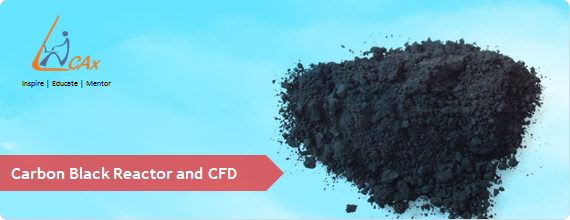Carbon Black Reactor Analysis using powerful tool CFD
Carbon Black (CB) is a material produced by the incomplete combustion of heavy petroleum products such as FCC (Fluid Catalytic Cracking) tar, coal tar, ethylene cracking tar, and a small amount of vegetable oil. It is a form of amorphous carbon that has a high surface area to volume ratio majorly used as a pigment and reinforcement in rubber and plastic products. CB is made in specially designed reactors operating at internal temperatures in the range of 2600 F to 3600 F.
Different grades of CB can be produced with varying aggregate size and structure and it is these differences that allow CBs to be used in a variety of application.

Applications of Carbon Black :
CB is heavily used in manufacturing of rubber, plastics and other products, the most common being (about 70%) as a pigment and reinforcing phase in automobile tires. Carbon black also helps conduct heat away from the tread and belt area of the tire, reducing thermal damage and increasing tire life. Carbon black particles are also employed in some radar absorbent materials and in photocopiers and laser printer toner, and other inks, paints also in coloring of resins and films. It is also a common material used for production of belts, hoses, and other non-tire rubber goods.

How large is the Carbon Black market ?
Total world production of carbon black was around 8,100,000 metric tons (8,900,000 short tons) in 2006. Worldwide carbon black consumption is currently 9 million tonnes p.a.,expected to reach 13 million by 2015. Average global growth will likely exceed 4% over the next five years, with China, India, and Central and Eastern Europe showing much higher demand, while capacity will shift geographically to meet demand. Some of the big players in this field are Philips Carbon Black, Sid Richardson Carbon Black Company, Continental Carbon Black Company and Birla Carbon Black.
How is Carbon Black manufactured ?
While there are several processes in which CB is made, among the common one is a furnace black process. In the furnace black process aromatic oils (based on crude oil) or combustible gases are burned in a reactor, producing carbon black and tail gas. After cooling, the CB is separated from tail gas, made more dense and processed into pellets of varying grades/sizes. This process is currently the most widely used in the market.
Where does CFD come into the picture ?
Use of Computational technology is required to maximize the efficiency of the CB manufacturing process as well to reduce the environmental impact of CB production. Computational Fluid Dynamics (CFD) is used in the CB manufacturing industry at various stages in the R&D cycle. CFD finds use in analyzing or simulating the interaction of liquids, gases and different surfaces within the manufacturing process inside the reactors. It is also used to model or design auxiliary units like cooling jackets. CFD models have also been implemented to virtually visualize the particulate sizes as well as combustion prior to introducing oil for CB production.

Image Source: www.ansys.com
How is CFD employed for design of CB reactor ?
CFD is employed to study and model the entire temperature distribution prior to introduction of combustion oils within the CB reactor. The application of CFD process involves solving or modeling flow equations consisting of five conservation equations of continuity, momentum and energy through a pressed based solution approach. Radiation models are also employed which consider radiation effects inside the high temperature process reactor. The combustion phenomenon is captured using different forms of combustion modeling techniques like non premixed combustion model along with chemical species modeling. Various commercial software have capabilities involving these above models and they can be efficiently used if an engineer possess the modeling skills. Using virtual computational environment CFD can help design engineers visualize velocity, pressure, temperature and chemical species distribution at various locations and during different stages of CB manufacturing process. The valuable information a CFD model provides can be utilized to come up with most efficient CB manufacturing process with minimized environmental effects.
CCTech expertise in the area of CFD for Carbon Black :
CCTech has established expertise in using CFD at various level of the Carbon Black manufacturing process.Our CFD based design studies have helped our valuable customers to make inroads into efficient equipment and process design for CB manufacturing. Some of the areas we have expertise in are listed below :
- Applying combustion modeling techniques to simulate combustion of air-gas mixture
- Particulate modeling inside CB reactor
- Flow modeling to study flow behaviour
- CFD modeling of auxiliary equipment like cooling jackets, inlet routes
- CFD modeling of mixing inside CB reactor
- Expertise in application of commercial software like FLUENT, STAR CCM+, ICEM, Comsol to simulate different process inside CB reactor.
The Author
{module [317]}